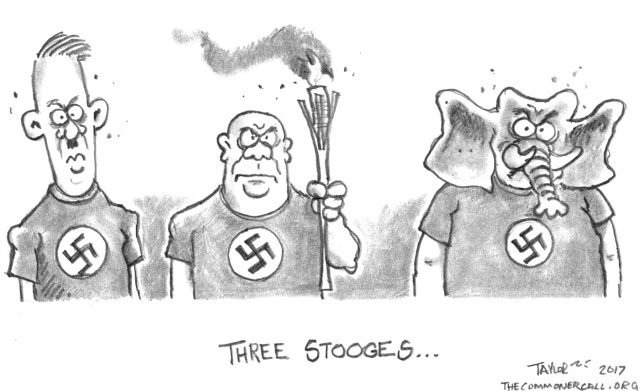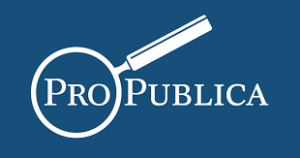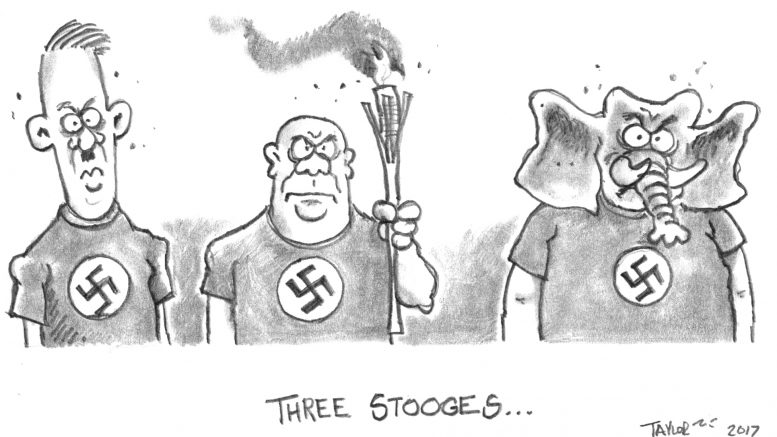
By A.C. Thompson, ProPublica, and Karim Hajj, special to ProPublica
ProPUblica (8/13/17)
The white supremacist forces arrayed in Charlottesville, Virginia, over the weekend — the largest gathering of its sort in at least a generation — represented a new incarnation of the white supremacy movement. Old-guard groups like the Ku Klux Klan, the Aryan Nations and the Nazi skinheads, which had long stood at the center of racist politics in America, were largely absent.
Instead, the ranks of the young men who drove to Charlottesville with clubs, shields, pepper spray and guns included many college-educated people who have left the political mainstream in favor of extremist ideologies over the past few years. A large number have adopted a very clean cut, frat-boyish look designed to appeal to the average white guy in a way that KKK robes or skinhead regalia never could. Interviews show that at least some of these leaders have spent time in the U.S. armed forces.
Many belong to new organizations like Vanguard America, Identity Evropa, the Traditionalist Workers Party and True Cascadia, which have seen their numbers expand dramatically in the past year. Most of these groups view themselves as part of a broader “alt-right” movement that represents the extreme edge of right-wing politics in the U.S.
These organizations exhibited unprecedented organization and tactical savvy. Hundreds of racist activists converged on a park on Friday night, striding through the darkness in groups of five to 20 people. A handful of leaders with headsets and handheld radios gave orders as a pickup truck full of torches pulled up nearby. Within minutes, their numbers had swelled well into the hundreds. They quickly and efficiently formed a lengthy procession and begun marching, torches alight, through the campus of the University of Virginia.
Despite intense interest from the media, police and local anti-racists, the white supremacists kept the location of their intimidating nighttime march secret until the last moment.
The next day, the far-right forces — likely numbering between 1,000 and 1,500 — marched to Emancipation Park. Once again, they arrived in small blocs under military-style command. The racist groups were at least as organized and disciplined as the police, who appeared to have no clear plan for what to do when the violence escalated. The racist groups stood their ground at the park and were not dislodged for many hours.
For many of them, this will be seen as victory. “Every rally we’re going to be more organized, we’re going to have more people, and it’s going to be harder and harder for them to shut us down,” said a spokesman for Vanguard America, a fascist group, who gave his name as “Thomas.” “White people are pretty good at getting organized.”
And though police arrested James Fields Jr., a 20-year-old Ohio man, for allegedly driving a Dodge Charger into a crowd of anti-racist protesters, killing 32-year-old Heather Heyer and wounding many others, the white supremacists generally avoided arrests.
They also outmaneuvered their anti-racist opponents. On Saturday, a multifaith group met at the historic First Baptist Church for a sunrise prayer ceremony featuring academic Cornel West and pastor Traci Blackmon. The anti-racists, many of them clergy members, walked quietly to Emancipation Park, where they were vastly outnumbered by the white supremacists.
Later, a band of more aggressive counter-protesters showed up at the park, chanting “Appalachia coming at ya. Nazi punks we’re gonna smash ya!” These militant “antifa,” or antifascists, were also repelled by the white supremacists.
Given the scale of the protests, the far-right groups suffered few injuries. That was particularly notable given the fact that multiple people near the protests were armed. Throughout the weekend, right-wing and left-wing militias equipped with assault rifles, pistols and body armor patrolled the streets of Charlottesville. (Virginia is an “open carry” state, so gun owners are legally allowed to tote around firearms.)
Many of the armed men viewed their role as maintaining a modicum of order. A “Three Percenter” militia out of New York state posted itself near Emancipation Park with the intention of keeping anti-racists from disrupting the rally. The group says it disapproves of racism but is dedicated to defending the free speech rights of all.
Blocks away, Redneck Revolt, a leftist militia from North Carolina, watched over the perimeter of a park where anti-racists had gathered, committed to preventing violent attacks by the white supremacist groups.
The presence of heavily armed citizens may have played a role in the decision of authorities to largely stay out of the violent skirmishes between the white supremacists and their opponents.
Those who actually marched included many new to the right-wing cause. The victory of Donald Trump in last year’s presidential election has energized a whole wave of young people who were previously apathetic or apolitical, rally organizer Eli Mosley told ProPublica. The president has served as “megaphone” for far-right ideas, he said.
Mosley and his comrades are seeking to draw in as many of these newly politicized young people as possible. “We’re winning,” he said. “We’re targeting the youth and making a movement that appeals to the youth.”
Some of those who’ve gravitated to the extreme right milieu are former liberals — like Mosley’s fellow rally organizer Jason Kessler — and supporters of Bernie Sanders. Many are ex-Libertarians.
“I was a libertarian,” said Mosley, as white supremacists chanted “Whose streets? Our streets!” in the background. “I looked around and noticed that most Libertarians were white men. I decided that the left was winning with identity politics, so I wanted to play identity politics too. I’m fascinated by leftist tactics, I read Saul Alinsky, Martin Luther King … This is our ’60s movement.”
(Commoner Call cartoon by Mark L. Taylor, 2017. Open source and free to use with link to www.thecommonercall.org )
*****
Police Stood By Passively As Mayhem Mounted In Charlottesville
By A.C. Thompson and Robert Faturechi, ProPublica, and Karim Hajj, special to ProPublica
ProPublica (8/14/17)
There was nothing haphazard about the violence that erupted today in this bucolic town in Virginia’s heartland. At about 10 a.m. today, at one of countless such confrontations, an angry mob of white supremacists formed a battle line across from a group of counter-protesters, many of them older and gray-haired, who had gathered near a church parking lot. On command from their leader, the young men charged and pummeled their ideological foes with abandon. One woman was hurled to the pavement, and the blood from her bruised head was instantly visible.
Standing nearby, an assortment of Virginia State Police troopers and Charlottesville police wearing protective gear watched silently from behind an array of metal barricades – and did nothing.
It was a scene that played out over and over in Charlottesville as law enforcement confronted the largest public gathering of white supremacists in decades. We walked the streets beginning in the early morning hours and repeatedly witnessed instances in which authorities took a largely laissez faire approach, allowing white supremacists and counter-protesters to physically battle.
Officials in Charlottesville had publicly promised to maintain control of the “Unite the Right” rally, which is the latest in a series of chaotic and bloody racist rallies that have roiled this college town, a place deeply proud of its links to Thomas Jefferson and the origins of American Democracy.
Months planning for war
But the white supremacists who flooded into the city’s Emancipation Park – a statue of Confederate General Robert E. Lee sits in the center of the park – had spent months openly planning for war. The Daily Stormer, a popular neo-Nazi website, encouraged rally attendees to bring shields, pepper spray, and fascist flags and flagpoles. A prominent racist podcast told its listeners to come carrying guns. “Bring whatever you need, that you feel you need for your self defense. Do what you need to do for security of your own person,” said Mike “Enoch” Peinovich on The Right Stuff podcast.
And the white supremacists who showed up in Charlottesville did indeed come prepared for violence. Many wore helmets and carried clubs, medieval-looking round wooden shields, and rectangular plexiglass shields, similar to those used by riot police.
Clad in a black, Nazi-style helmet, Matthew Heimbach told ProPublica, “We’re defending our heritage.” Heimbach, who heads the Traditionalist Workers Party, a self-declared fascist group, said he was willing to die for his cause and would do whatever it took to defend himself. He was surrounded by a brigade of white supremacists, including members of the League of the South and the National Socialist Movement.
From shoving to wild melees
By the time Heimbach and his contingent arrived in downtown Charlottesville shortly before 11 a.m., what had started hours earlier with some shoving and a few punches had evolved into a series of wild melees as people attacked one another with fists, feet, and the improvised weapons they’d brought with them to the park. White supremacists and anti-racists began blasting each other with thick orange streams of pepper spray.
The police did little to stop the bloodshed. Several times, a group of assault-rifle-toting militia members from New York State, wearing body armor and desert camo, played a more active role in breaking up fights.
Shortly before noon, authorities shut down the rally and the related demonstrations and marched the white supremacists out of the park and into the streets.
Twiddling their thumbs
Charlottesville Vice Mayor Wes Bellamy defended the police tactics. “I’m not in the business of throwing our police department under the bus, because they’re doing the best job they can,” said Bellamy. “I don’t think the police officers were just twiddling their thumbs.”
The skirmishes culminated in what appears to have been an act of domestic terrorism, with a driver ramming his car into a crowd of anti-racist activists on a busy downtown street, killing one and injuring 19 according to the latest information from city officials. Charlottesville authorities tonight reported that a 20-year-old Ohio man had been arrested and had been charged with murder.
Two state police officers also died in a helicopter crash.
At a brief press conference this evening, Virginia officials declined to answer questions about the police response, but said they were not taken surprise by the violence or the number of protesters. “This could have been a much worse day,” said Virginia Gov. Terry McAuliffe, “We planned for a long time for today’s incidents.”
Charlottesville police Chief Al Thomas said at least 35 people had been injured – many of them from violent encounters between white supremacists and the counter-protesters. He said nobody had been wounded due to confrontations between police and the public.
In the weeks leading up to the protest, city and state officials put together a detailed plan for the rally, mobilizing 1,000 first responders, including 300 state police troopers and members of the National Guard. Judging from how events unfolded today, it appears that the strategy was to avoid direct confrontations with the protesters.
Miriam Krinsky, a former federal prosecutor who has worked on police reform efforts in Los Angeles, said it was too early to assess the law enforcement response in Charlottesville.
But she said a strategy of disengagement generally works to embolden unruly crowds.
“If things start to escalate and there’s no response, it can very quickly get out of control,” she said. “Individuals can and will get hurt.”
But an overly forceful response, she said, can also make the situation worse. Krinsky said attempts to seize weapons might have led to more clashes between police and protesters. “Trying to take things away from people is unlikely to be a calming influence,” she told ProPublica.
A good strategy, she said, is to make clashes less likely by separating the two sides physically, with officers forming a barrier between them. “Create a human barrier so the flash points are reduced as quickly as possible,” she said.
A.C. Thompson and Karim Hajj reported from Charlottesville, Va. Robert Faturechi reported from New York.
*****


